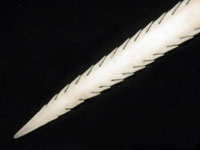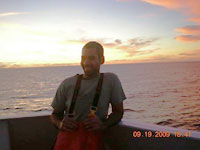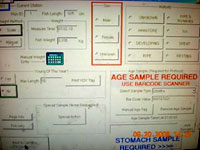

 | |||||||||||||||||||
|
|
Journals 2009/2010Beth Brocato
September 21, 2009 The first catch of the night watch today yielded an almost entire net full of stingrays. This is not altogether unusual because stingrays have mouths on their undersides and are typically found feeding off of the ocean bottom. Cutting open their stomachs you will generally find crabs, squid and some shellfish.
Stingrays are a bit tricky to process for a couple of reasons. First being their size. Some of the largest stingrays are bigger than the average man. These rays had to be weighed with the on-deck crane and measured with measuring tapes. Then they are hefted over the deck railing, back into the sea. The smaller rays are processed through the conveyor belt sorter inside. Another reason stingrays are tricky to process is that their tails contain a sharp barb. This barb can be very dangerous if the whip-like tail of the ray impales you. This is how Steve Irwin died. The scientists have to de-barb all of the rays before they come in to be processed.
I also wanted to introduce you to a couple of people who are on my watch. The first is April. April is the only other female on my watch. She is a lot of fun. She is from Virginia, but currently works at a NOAA lab in Connecticut where she studies oyster blood and analyzes oyster immunities.
Another crewmember on my watch is Frank. Frank is my analyzing partner. Once the catch has been sorted, a pair known as a cutter and a recorder report to their data stations. Frank uses the fish board to measure, weigh and cut each and every fish in a sort. It is my job to record the length weight, sex, stomach contents and to collect fish otoliths.
QUESTION: What other fish is closely related to the stingray? |
||||||||||||||||||




